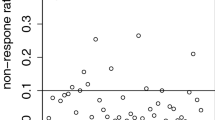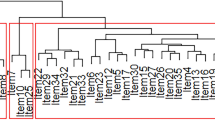Abstract
Multiple choice items on tests and Likert items on surveys are ubiquitous in educational, social and behavioral science research; however, methods for analyzing of such data can be problematic. Multidimensional item response theory models are proposed that yield structured Poisson regression models for the joint distribution of responses to items. The methodology presented here extends the approach described in Anderson, Verkuilen, and Peyton (2010) that used fully conditionally specified multinomial logistic regression models as item response functions. In this paper, covariates are added as predictors of the latent variables along with covariates as predictors of location parameters. Furthermore, the models presented here incorporate ordinal information of the response options thus allowing an empirical examination of assumptions regarding the ordering and the estimation of optimal scoring of the response options. To illustrate the methodology and flexibility of the models, data from a study on aggression in middle school (Espelage, Holt, and Henkel 2004) is analyzed. The models are fit to data using SAS.
Similar content being viewed by others
References
AGRESTI, A., CHUANG, C., and KEZOUTH, A. (1987), “Order-Restricted Score Parameters in Association Models for Contingency Tables”, Journal of the American Statistical Assocation, 82, 619–623.
AGRESTI, A. (2002), Categorical Data Analysis (2nd ed.), New York: Wiley.
ANDERSEN, E.B. (1995), “The derivation of polytomous Rasch models”, in Rasch Models: Foundations, Recent Developments, and Applications, eds. G.H. Fischer and I.W. Molenaar, New York: Springer, pp. 271–291.
ANDERSON, C.J. (2009), “Categorical Data Analysis with a Psychometric Twist”, in The Sage Handbook of Quantitative Methods in Psychology, eds. R.E. Millsap and A. Maydeu-Olivares, Thousand Oaks, CA: Sage, pp. 311–336.
ANDERSON, C.J., LI, Z., and VERMUNT, J.K. (2007), “Estimation of Models in a Rasch Family for Polytomous Items and Multiple Latent Variables”, Journal of Statistical Software, 20, published online at http://www.jstatsoft.org/v20/i06/paper.
ANDERSON, C.J., VERKUILEN, J.V., and PEYTON, B.L. (2010), “Modeling Polytomous Item Responses Using Simultaneously Estimated Multinomial Logistic Regression Models”, Journal of Educational and Behavioral Statistics, 35, 422–452.
ANDERSON, C.J., and VERMUNT, J.K. (2000), “Log-Multiplicative Association Models as Latent Variable Models for Nominal and/or Ordinal Data”, Sociological Methodology, 30, 81–121.
ANDERSON, C.J., and YU, H.T. (2007), “Log-Multiplicative Association Models as Item Response Models”, Psychometrika, 72, 5–23.
ANRAKU, K. (1999), “An Information Criterion for Parameters Under a Simple Order Restriction”, Biometrika, 86, 141–152.
BARTHOLOMEW, D.J., STEELE, F., MOUSTAKI, I., GALRAITH, J.I. (2008), Analysis of Multivariate Social Science Data, Boca Raton, FL: CRC Press.
BARTOLUCCI, F., and FORCINA, A. (2002), “Extended RC Association Models Allowing for Order Restrictions and Modelling”, Journal of the American Statistical Association, 97, 1192–1199.
BECKER, M.P. (1989), “Models for the Analysis of Association in Multivariate Contingency Tables”, Journal of the American Statistical Association, 84, 1014–1019.
BISHOP, Y.M.M., FIENBERG, S.E., and HOLLAND, P.W. (1975), Discrete Multivariate Analysis, Cambridge, MA: MIT Press.
BOCK, D.R., GIBBONS, SCHILLING, S.G., MURAKI, E., WILSON, D.T., and WOOD, R. (2003), TESTFACT 4.0 Computer Software and Manual, Lincolnwood, IL: Scientific Software International.
DE LA TORRE, J. (2009), “Improving the Quality of Ability Estimates Through Multidimensional Scoring and Incorporation of Ancillary Variables”, Applied Psychological Measurement, DOI:10.1177/0146621608329890, published online at http://apm.sagepub.com/content/33/6/465.short.
DE BOECK, P, and WILSON, M. (2004), Explanatory Item Response Models: A Generalized Linear and Nonlinear Approach, New York: Springer.
ESPELAGE, D.L., and HOLT, M.K. (2001), “Bullying and Victimization During Early Adolescence”, Journal of Emotional Abuse, 2, 123–142.
ESPELAGE, D.L., HOLT, M.K., and HENKEL, R.R. (2004), “Examination of Peer-Group Contextual Effects on Aggression During Early Adolescence”, Child Development, 74, 205–220.
FAHRMEIR, L., and TUTZ, G. (2001), Multivariate Statistical Modelling Based on Generalized Linear Models, New York: Springer.
FISHER, G.H. (1997), “Unidimensional Linear Logistic Rasch Models”, in Handbook of Modern Item Response Theory, eds. W.J. van der Linden and R.K. Hambletion, New York: Springer, pp. 225–243.
GALINDO-GARRE, F., and VERMUNT, J.K. (2004), “The Order-Restricted Association Model: Two Estimation Algorithms and Issues in Testing”, Psychometrika, 69, 641–654.
GALINDO-GARRE, F., and VERMUNT, J.K. (2005), “Testing Log-Linear Models with Ordinal Constraints: A Comparison of Asymptotic, Bootstrap, and Posterior Predictive p-Values”, Statistica Neerlandica, 59, 82–94.
GLAS, C.A.E. (2005), “Review of de Bock, P. and Wilson, M. Explanatory Item Response Theory Models: A Generalized Linear and Nonlinear Approach”, Journal of Educational Measurement, 42, 303–307.
GOODMAN, L.A. (1979), “Simple Models for the Analysis of Association in Cross-Classifications Having Ordered Categories”, Journal of the American Statistical Association, 74, 537–552.
GOODMAN, L.A. (1985), “The Analysis of Cross-Classified Data Having Ordered and/or Unordered Categories: Association Models, Correlation Models, and Asymmetry Models for Contingency Tables With or Without Missing Entries”, The Annals of Statistics, 13, 10–69.
HABERMAN, S.J. (1995), “Computation of Maximum Likelihood Estimates in Association Models”, Journal of the American Statistical Association 90, 1438–1446.
HEINEN, T. (1993), Discrete Latent Variable Models, The Netherlands: Tilburg University Press.
HEINEN, T. (1996), Latent Class and Discrete Latent Trait Models: Similarities and Differences, Thousand Oaks: Sage Publications, Inc.
HOLLAND, P.H. (1990), “The Dutch Identity: A New Tool for the Study of Item Response Models”, Psychometrika, 55, 5–18.
ILIOPOULOS, G., KATERI, M., and NTZOUFRAS, I. (2007), “Bayesian Estimation of Unrestricted and Order-Restricted Association Models for Two-Way Contingency Tables”, Computational Statistics and Data Analysis, 51, 4643–4655.
ILIOPOULOS, G., and KATERI, M., and NTZOUFRAS, I. (2009), “Bayesian Comparison for the Order Restricted RC Association Model”, Psychometrika, 74, 561–587.
JOE, H., and LIU, Y. (1996), “A Model for Multivariate Binary Response with Covariates Based on Conditionally Specified Logistic Regressions”, Statistics and Probability Letters, 31, 113–120.
JUNKER, B.W. (1993), “Conditional Association, Essential Independence and Monotone Unidimensional Item Response Models”, Annals of Statistics, 21, 1359–1378.
JUNKER, B.W., and SIJTSMA, K. (2000), “Latent and Manifest Monotonicity in Item Response Models”, Applied Psychological Measurement, 24, 65–81.
LI, Z. (2010), Loglinear Models as Item Response Models, unpublished doctoral dissertation, University of Illinois at Urbana-Champaign.
LINTING, M., MEULMEAN, J.J., GROENEN, P.J.F., and VAN DER KOOIJ, A.J. (2007), “Nonlinear Principle Components Analysis: Introduction and Applications”, Psychological Methods, 12, 336–358.
MCDONALD, R.P. (1997), “Normal-ogive multidimensional model” in Handbook of Modern Item Response Theory, eds. W.J. van der Linden and R.K. Hambleton, New York: Springer.
RECKASE, M.D. (2009), Multidimensional Item Response Theory, New York: Springer.
RIJMEN, F., TUERLINCKX, F., DE BOECK, F., and KUPPENS, P. (2003), “A Nonlinear Mixed Model Framework for Item Response Theory”, Psychological Methods, 8, 185–205.
RITOV, Y., and GILULA, Z. (1991), “The Order-Restricted RC Model for Ordered Contingency Tables: Estimation and Testing for Fit”, Annals of Statistics, 19, 2090–2101.
RUTKOWSKI, L., VASTERLING, J.V., PROCTER, S.P., and ANDERSON, C.J. (2010), “Posttraumatic Stress Disorder and Standardized Test-Taking Ability”, Journal of Educational Psychology, 102, 223–233.
SHIEU, C.F., CHEN, C.T., SU, Y.H., and WANG, W.C. (2005), “Using SAS PROC NLMIXED to Fit Item Response Theory Models”, Behavior Research Methods, 37, 202–218.
TETTEGAH, S., and ANDERSON, C.J. (2007), “Pre-service Teachers’ Empathy and Cognitions: Statistical Analysis of Text Data by Graphical Models”, Contemporary Educational Psychology, 32, 48–82, published online at http://dx.doi.org/10.1016/j.cedpsych.2006.10.010.
THOMAS, N. (2002), “The Role of Secondary Covariates When Estimating Latent Trait Population Distributions”, Psychometrika, 67, 33–48.
VERMUNT, J.K. (1997), ℓEM: A General Program for the Analysis of Categorical Data (Computer Software Manual), Tilburg, The Netherlands. Published online at http://members.home.nl/jeroenvermunt/.
VERMUNT, J.K. (1999), “A General Class of Nonparametric Models for Ordinal Categorical Data”, Sociological Methodology, 29, 187–223.
WANG, W.C., CHEN, P.H., and CHEN, Y.Y. (2004), “Improving Measurement Precision of Test Batteries Using Multidimensional Item Response Models”, Psychological Methods, 9, 116–136.
WONG, R.S. (1995), “Extensions in the Use of Log-Multiplicative Scaled Association Models in Multiway Contingency Tables”, Sociological Methods and Research, 23, 507–538.
WONG, R.S. (2001), “Multidimensional Association Models: A Multilinear Approach”, Sociological Methods and Research, 30, 197–240
YEE, T.W., and HASTIE, T. J. (2003), “Reduced-Rank Vector Generalized Linear Models”, Statistical Modelling, 3, 1541.
YEE, T.W. (2010), “The VGAM Package for Categorical Data Analysis”, Journal of Statistical Software, 32, 1–34, published online at http://www.jstatsoft.org/v32/i10/.
ZWINDERMAN, A.H. (1991), “A Generalized Rasch Model for Manifest Predictions”, Psychometrika, 56, 589–600.
ZWINDERMAN, A.H. (1997), “Response Models with Mainfest Predictors”, in Handbook of Modern Item Response Theory, eds. W.J. van der Linden and R.K. Hambletion, New York: Springer, pp. 245–256.
Author information
Authors and Affiliations
Corresponding author
Additional information
A special thanks goes to Dorothy Espelage for the use of her data.
Rights and permissions
About this article
Cite this article
Anderson, C.J. Multidimensional Item Response Theory Models with Collateral Information as Poisson Regression Models. J Classif 30, 276–303 (2013). https://doi.org/10.1007/s00357-013-9131-x
Published:
Issue Date:
DOI: https://doi.org/10.1007/s00357-013-9131-x




